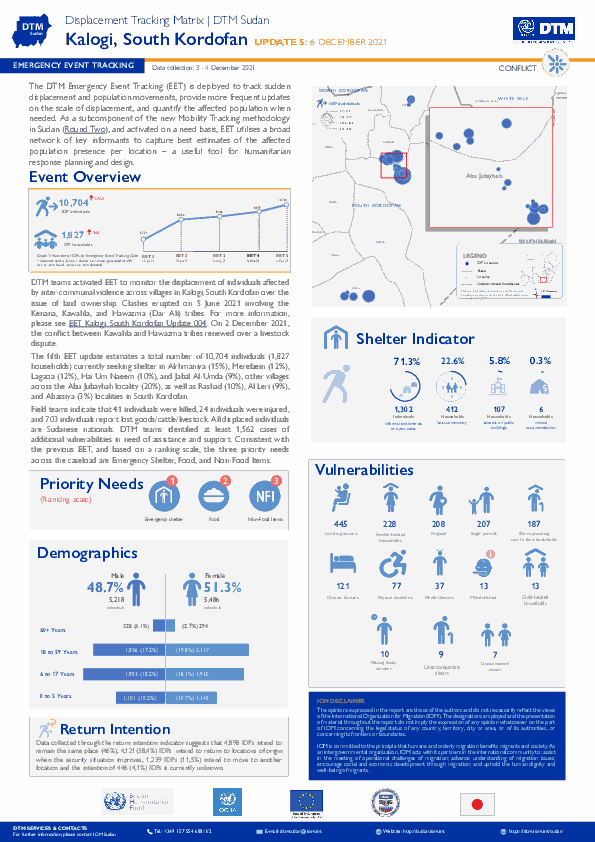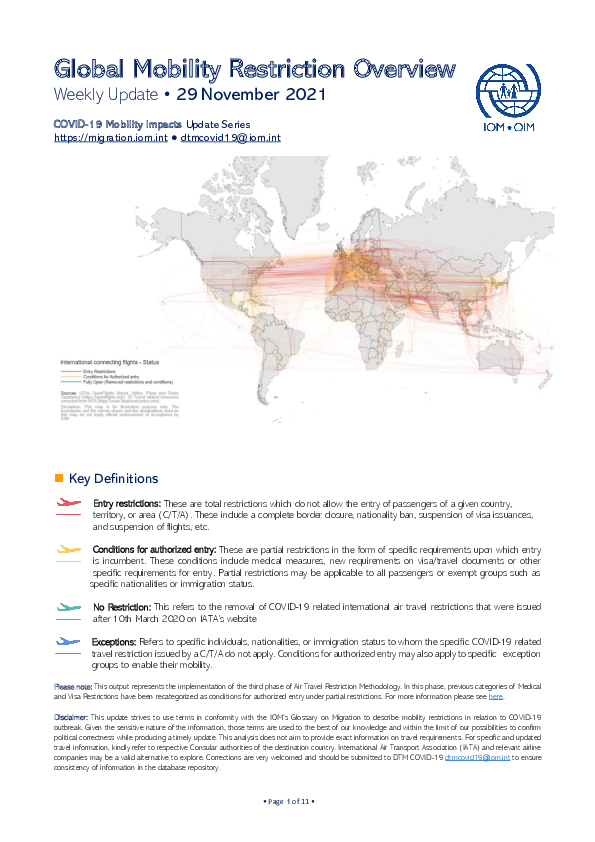-
Countries
-
Data and Analysis
-
Special Focus
-
Crisis Responses

Contact
DTM Mozambique, DTMMozambique@iom.int
Language
English
Location
Mozambique
Period Covered
Dec 04 2021
Dec 04 2021
Activity
- Site Assessment
- Mobility Tracking
Due to the hostilities in Naulala and its environs (approximately 60 kilometers from Mecula Sede), which are located in the Mecula district of Niassa province, on 4 December 2021, IOM's DTM team in conjunction with Mozambique’s National Institute for Disaster Management and Risk Reduction (INGD), conducted an assessment in the displacement location of EPC Mecula (a school that is currently being used as a temporary accommodation centre; located in Mutopene bairro in Mecula sede of Mecula district). According to the assessment, this centre houses an estimated 682 individuals (205 households).
All of the displaced people attributed their movements to heightened hostilities and fears of insecurity in their home communities. The majority of IDPs cited Naulala and Gomba as their previous residences.
Results from the assessment show that while IDP families have received some form of shelter assistance (NFIs, emergency shelter, technical, and labor assistance), and nearly 75 per cent of displaced families have received some form of food distribution, all of the aforementioned assistance came from INGD. While all of the aforementioned assistance came from INGD, the IDPs remain in desperate need of additional humanitarian assistance.

Contact
DTM Sudan; dtmsudan@iom.int
Language
English
Location
Sudan
Period Covered
Dec 03 2021
Dec 04 2021
Activity
- Event Tracking
- Mobility Tracking
The DTM Emergency Event Tracking (EET) is deployed to track sudden displacement and population movements, provide more frequent updates on the scale of displacement, and quantify the affected population when needed. As a subcomponent of the new Mobility Tracking methodology in Sudan (Round Two), and activated on a needs basis, EET utilises a broad network of key informants to capture best estimates of the affected population presence per location – a useful tool for humanitarian response planning and design.
Dec 06 2021
Print
Countries in this response
- Active DTM operation
- Past DTM operation

Contact
DTM Nigeria, AllUsersInDTMNigeria@iom.int
Language
English
Location
Nigeria
Period Covered
Nov 21 2021
Dec 01 2021
Activity
- Event Tracking
- Mobility Tracking
As part of the IDP relocation programme issued by the Borno State Government (BSG), the IDPs residing in Bakasi Camp were relocated to their LGAs of origin.
On 21 November 2021, the Borno State Government (BSG) commenced the relocation of the IDPs residing in Bakasi Camp, located in Maisandari ward in the MMC LGA of Borno State. Following this event, a rapid assessment was conducted by DTM field staff in order to capture these IDP movements, inform the humanitarian community and enable targeted assistance to the BSG. Flash reports utilise direct observation and a broad network of key informants to gather representative data and collect information on the number, profile and immediate needs of the repatriated population.
Between 21 November and 01 December, an estimated number of 4,378 individuals or 769 households were relocated from Bakasi Camp to various locations in the state. Parts of the IDP population organised the relocation themselves, others were assisted by the Borno State Government. Of the total IDP movement, 955 individuals or 161 households relocated to camps or camp-like settings in Gwoza LGA, while 2,029 individuals or 347 households were hosted by the local communities of Gwoza LGA. Camps and camp-like settings in Monguno welcomed a total of 889 individuals in 169 households, while 505 individuals in 92 households are currently hosted by communities in Monguno LGA.
Contact
revina@iom.int
Location
Zimbabwe
Activity
- Mobility Tracking
- Baseline Assessment
Period Covered
Mar 13 2019 -May 14 2019
A baseline assessment is a sub-component of mobility tracking. It aims to collect data on IDP, migrant or returnee population presence in a defined administrative area of the country.
Population Groups
Survey Methodology
Unit of Analysis Or Observation
Type of Survey or Assessment
Keywords
Geographical Scope
Administrative boundaries with available data
The current dataset covers the following administrative boundaries

Contact
DTMcovid19@iom.int
Language
English
Location
Global
Snapshot Date
Nov 29 2021
Activity
- Other
The current outbreak of COVID-19 has affected global mobility in the form of various travel disruptions and restrictions. To better understand how COVID-19 affects global mobility, DTM has developed a COVID-19 database mapping the different restrictions to provide a global overview. For this, DTM uses the IATA site as the primary source of restrictions with the information reported per country and territory, and to the country of application.
Data collected includes:
- Date of restriction
- Country, territory or area of restriction
- Countries, territories or areas on which restrictions were imposed
- Type of restriction- total restriction, or conditional restriction – such as medical/ and or visa restriction
This DTM COVID-19 Travel Restrictions Output presents an analysis based on country imposing, the country being imposed upon, and the aggregation of the restriction type. The aim of the data analysis is to provide an overview of the COVID-19 outbreak on global mobility and to help identify and develop responses.

Contact
DTM Nigeria, AllUsersInDTMNigeria@iom.int
Language
English
Location
Nigeria
Period Covered
Nov 22 2021
Nov 28 2021
Activity
- Event Tracking
- Mobility Tracking
Between 22 and 28 November 2021, a total of 5,272 movements were recorded in the states of Adamawa and Borno. The recorded movements consisted of 4,635 arrivals and 637 departures. Arrivals were recorded at locations in Askira/Uba, Bama, Damboa, Gwoza Kala/Balge, Monguno and Ngala Local Government Areas (LGAs) of the most conflict-affected state of Borno and in Fufore, Girei, Gombi, Hong, Lamurde, Maiha, Michika and Mubi South LGAs of Adamawa.
Departures were recorded in Askira/Uba, Bama and Kala/Balge LGAs of Borno, and Hong, Maiha, Michika, Mubi South, Numan, Song, Yola North and Yola South LGAs of Adamawa.
ETT assessments identified the following movement triggers: voluntary relocation (2,403 individuals or 46%), improved security (1442 individuals or 27%), poor living conditions (802 individuals or 15%), fear of attacks (596 individuals or 11%), seasonal farming (27 individuals or less than 1%) and conflicts/attacks (2 individuals or less than 1%).

Contact
DTMMozambique@iom.int
Language
English
Location
Mozambique
Period Covered
Sep 01 2021
Nov 30 2021
Activity
- Event Tracking
- Mobility Tracking
During the reporting period (September to November 2021), a total of 14 movements were recorded - 6 departures (880 individuals) and 8 arrivals (404 individuals). The arrivals were recorded in Cidade de Nampula, Erati and Meconta. The departures were recorded in Erati, Meconta, Memba and Nacala. Forty-five per cent of total of the population had been displaced twice, while 55 per cent had been displaced three times.

Contact
DTMMozambique@iom.int
Language
English
Location
Mozambique
Period Covered
Nov 24 2021
Nov 30 2021
Activity
- Event Tracking
- Mobility Tracking
During the reporting period (24 to 30 November 2021), a total of 55 movements were recorded - 16 transits (3,322 individuals), 21 arrivals (603 individuals), 6 intended return movements (681 individuals), and 12 departures (576 individuals). The largest transits were recorded in Mueda (3,181 individuals) and Nangade (104 individuals). The largest arrivals were recorded in Nangade (337 individuals) and Mueda (217 individuals). The intended return movements were observed in Mueda (535 individuals) and Montepuez (132 individuals). The largest departures were recorded in Mueda (385 individuals) and Balama (165 individuals). Of the total population (5%) were displaced for the first time. An estimated 95 per cent of reported IDPs had been displaced more than once prior to this latest movement.

Contact
DTM Sudan; dtmsudan@iom.int
Language
English
Location
Sudan
Snapshot Date
Nov 30 2021
Activity
- Event Tracking
- Mobility Tracking
The DTM Emergency Event Tracking (EET) is deployed to track sudden displacement and population movements, provide more frequent updates on the scale of displacement, and quantify the affected population when needed. As a subcomponent of the new Mobility Tracking methodology in Sudan (Round Two), and activated on a need basis, EET utilises a broad network of key informants to capture best estimates of the affected population presence per location – a useful tool for humanitarian response planning and design.